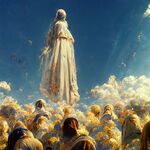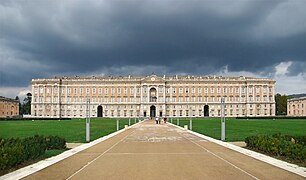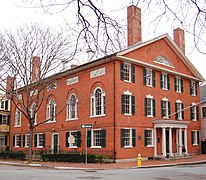Arts and literature of Urcea
This article is a work-in-progress because it is incomplete and pending further input from an author. Note: The contents of this article are not considered canonical and may be inaccurate. Please comment on this article's talk page to share your input, comments and questions. |
The arts and literature of Urcea are reflective of key social characteristics of the people of Urcea and the history of its cultural development, being primarily inclusive of greater Latinic traditions while incorporating some elements of Gaelic culture. Throughout its history, the written and visual arts of Urcea have been profoundly impacted by the role of the Catholic Church in Urcean society, with a preponderance of its great works containing or alluding to religious themes. Ómestaderoi living and concepts of the frontier - both the Urcean frontier and the historic discovery and expansion of the Latin Heroic Age, and similarities between these eras - also feature prominent throughout literature, artwork, and in some cases architecture. The history of Urcea and its role in Levantia are also common themes.
Art
The history of Urcean visual art is part of Levantine painting history. Levantine art was influenced by earlier Adonerii civilization and can in part be taken as a descendant thereof. However, Levantine painting does have important unique characteristics. Such painting can be grouped into 4 main "styles" or periods, and may contain the first examples of trompe-l'œil, pseudo-perspective, and pure landscape.
Panel painting became more common during the Levanesque period, under the heavy influence of Istroyan icons. Towards the middle of the 13th century, Medieval art and Gothic painting became more realistic, with the beginnings of interest in the depiction of volume and perspective in Urcea. From then on, the treatment of composition by the best painters also became much more free and innovative. Despite later adaptation of theme and subject, realistic painting has remained a popular form of painted art since the medieval period. Urcean art is centered around technical and realistic execution, retaining form while the content and how it is depicted has become more diverse.
Baroque

Initially serving imperial, private, civic, and religious patronage, Urcean painting later found audiences in the aristocracy and the middle class. From the Middle Ages through the Renaissance painters worked for the church and a wealthy aristocracy. Beginning with the Baroque era, artists received private commissions from a more educated and prosperous middle class. These changes occurred in the contest of the Catholic victory following the Great Confessional War and rejuvenation of Catholic art and architecture as the aesthetic component of the Counter Reformation. Accordingly, the demand for art across most of Urcean society was greatly enhanced during this period, leading to additional developments over time.
Romanticism

Art in Urcea continued to develop out of purely theological and patronage-based systems. The idea of "art for art's sake" began to find expression in the work of the Romantic painters, the most famous of which was Thomas Comhale, whose paintings of Ionian Highlands and scenes in the eastern Urcean valley were embraced as a "uniquely Urcean artistic school" during the period of the Recess of the Julii and Aedanicad. During this period, ideas about subject in art began to diverge, with historical events and people giving way to a more freeform selection of abstract locations and objects painted in the Romantic style. Many of this period's landscape portraits also depicted scenes of the Urcean frontier, extolling the virtues of Ómestaderoi living as part of a greater popularity of these themes and locations coinciding with the rise of Urcean frontier literature.
The Romantic art style remained popular in Urcea long after it had been supplanted elsewhere and it was valued as the "art of the common people and their inheritance in the land of Urcea", as Aedanicus VIII put it in 1863. Urcean Romanticism heavily featured both landscapes and historical scenes in addition to Biblical and pseudo-historical scenes, especially in the well known The Course of Empire series of paintings by Comhale which depict the rise and fall of a classic Latinic civilization. During the 19th century commercial galleries became established and continued to provide patronage in the 20th century. The Neo-Romantics resumed this style and genre of art following the victory of Urcea in the Second Great War, peaking in the early 1950s.
Skepticism

In the early 20th century, Romantic and realistic scenes were replaced by artists with the "skeptical" style. This style is defined by semi-surreal scenes with otherwise identifable objects which includes a hidden criticism of contemporary society that is intentionally not evidently apparent by a plain viewing of the art. The Urcean skeptical style, which flourished between the First Great War and Second Great War was viewed by contemporaries as sophisticated and esoteric, while it was popularly and critically scorned as elitist and complex for its own sake. Due to the period in which it became popular, many of the famous skeptical works are veiled critiques at life in Urcea during the Restoration period, focusing on social ills and the changes coming to the country as a result of a century of modernization.
Factual surrealism

Factual surrealism is a style of art which depicts surreal abstractions of commonly accepted beliefs and orthodox teachings of the Catholic Church, the preeminent social institution in Urcea. It depicts religious and historical scenes related to scripture or Urcean history, though many of the historical paintings are imbued with historic meaning. The factual surrealist style is intended, though with technical precision, to immerse the viewer in the "sense and glory" of the particular subject. Most artists of this style say they seek to capture the "perfect otherness" of the divine in their work.
This style emerged in the late 20th century, developing out of a revival of the skeptical style of depiction but replacing the esoteric and secret meaning with more traditional themes and readily apparent meanings. One of the most famous contemporary Urcean artists, Téodóir Ludovictor, described the style as "the appearance of the Skeptical with the soul of the Baroque". Factual surrealism is conceived by many art critics as a summation of Urcean art throughout history, blending the topics of the Baroque period, the color, lighting, and technical execution of the Romantic period, and the uncertain form of the skeptical period.
Architecture
Urcea has a long history of distinct architectural styles and innovation within architecture. The first of the "great" Urcean architectural styles were established just after the end of the Great Confessional War at the height of the Counter Reformation: the Rococo style of architecture, best expressed perahaps in both Electorsbourg and the Hermitage. The long period of Rococo ubiquity ended in the first decades of the 18th century, and its opulance was replaced by the more restrained Palladian style. Developing from Palladianism is among the most popular and commonly used kind of architecture in Urcea, the so-called Caroline architecture and associated pseudo-Caroline and neo-Caroline designs, which used brick and significant symmetry in its design. This style emphasized a type of humility and virtue in foregoing particular arthictectural and material excess in favor of sacrifice for both God and the nation, as was typical of the national awakening undergone in Urcea in the 18th and 19th centuries. Many great structures from this period are still extant alongside the Rococo masterpieces due to rapid growth during the early industrial revolution in the mid-18th century. An offshoot of Neoclassical architecture, Caroline architecture typically uses plain surfaces with attenuated detail, usually isolated in panels, tablets, and friezes. It also had a flatter, smoother façade and rarely used pilasters. It was most influenced by the interpretation of the ancient architecture of Great Levantia, which was growing in popularity in the mid-18th century due to increasing interest in archaeology. Many of Urcea's great architecutral achievements were inspired by or are those of Great Levantia, such as the construction of arches, domes and similar structures. The subdued Caroline style was replaced during the Aedanicad with Gothic Revival as well as a renewal of Rococo architecture, which was intended to show the new grandeur and strength of the nation by calling back to earlier architectural glories.
-
Rococo artchitecture in Urcea is perhaps best exemplified by Electorsbourg.
-
Following the excesses of Rococo, more subtle Palladian styles became common in public and civic use, such as seen here in the interior of Cálfeld's Cathedral Basilica of St. Anne.
-
Palladianism evolved into the even further restrained style of Caroline architecture, as exemplified by Melisbal Guild Hall, emphasizing virtue and humility.
-
Urcea's newfound cultural and political heights lead to the adoption of Gothic Revival styles, as seen at Urceopolis's Praetorium after its 1863 renovation, replaced the more subdued Caroline style.
Literature
Urcean literature refers to the literature of Urcea as well as older literature written in the Lebhan language. It may also refer to literature written by Urceans or Urcean emigres elsewhere, especially in Levantia. Urcean literature is considered to have begun in the 12th century when, in different regions of the Kingdom, the slowly standardizing Lebhan language started to be used in a literary manner. Urcean literature continued on past the adoption of Julian Ænglish as the national language.
The earliest literature which can be considered Urcean dates back to the centuries following the fall of Great Levantia. During this time, many iterative works of the Great Levantine period - especially Lebhan language treatments of stories of the Latin Heroic Age - were popular, as well as theological treatises dealing with the fall of Great Levantia. Much of Urcean literature through about 1700 focused on the nature of the divine and its relation to human life, and consequently some of the greatest works of Christian devotional literature, including The Imitation of Christ and Dark Night of the Soul were written in Urcea. This focus on devotional literature set the foundation for later works in the Romantic period and specifically during the Aedanicad, which is considered to be the golden age of Urcean literature. This period saw the increasing interest in establishing a uniquely Urcean literature style as opposed to the general cultural history and mores of the Holy Levantine Empire, from which Urcea found itself increasingly estranged from during the Recess of the Julii. With the desire to produce uniquely Urcean literature and culture, a number of key new literary figures emerged, including novelists such as Téodóir Dostovenus, who wrote extensively about human nature and the duality of man, especially in works such as The Brothers Kerkinius.
Levantine and Medieval literature
Imperial and Renaissance literature
Recess literature
Frontier literature
During the 19th century, an influential genre known as "Frontier literature" developed out of the experience of Ómestaderoi novelists, depicting stories both from lived experience as well as the imagined historical experience of life on the Urcean frontier. These books explored human nature when isolated from the comforts of well-built societies and explored both the depths to which man can go as well as the furthest extents of deprivation that man can survive.
The Great Novel
During the Recess of the Julii period, the concept of the Great Novel was coined by scholars and critics. The Great Novel is a canonical novel that is thought to embody the essence of Urcea, generally written by a Urcean and dealing in some way with the question of Urcea's national character. While the concept originated as a method of categorization, during the mid-19th century a preponderance of great works of Urcean literature were written, many of them attempting to become the quintessential Great Novel which truly explored the depths of Urcean identity and its relationship to the world through fiction.
Restoration literature
War literature
Post-war literature
Contemporary literature
Regional & Vernacular literatures
Caneish literature
Gassavelian literature
Highlands literature
Theater
Theater in Urcea is based in the Occidental tradition and did not take on a unique dramatic identity until the 17th century, coinciding with the rise of Urcean theater music. Its history prior to the 17th century is somewhat obscured in the historical record, though most histories have included theater as a "minor" form of entertainment. Pre-17th century Urcean theater is typically presented as having represented many of the classics of antiquity, though considerable scholarly evidence in the 2020s suggested that the classic theatrical presentations of Great Levantia survived in greatly modified and adapted forms. Consequently, many early Urcean theatrical productions depicting events of the Great Interregnum and other events are now considered to be ahistorical, adapting earlier stories by placing them within the context of later historical events.



